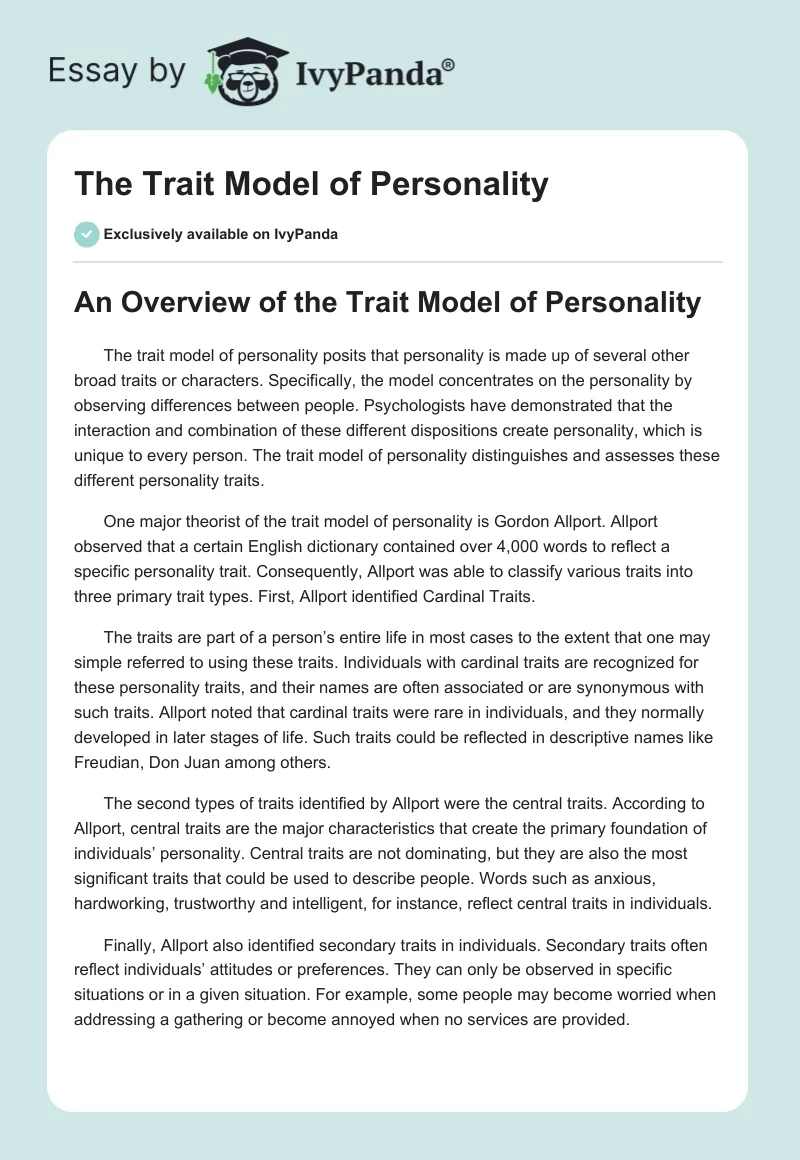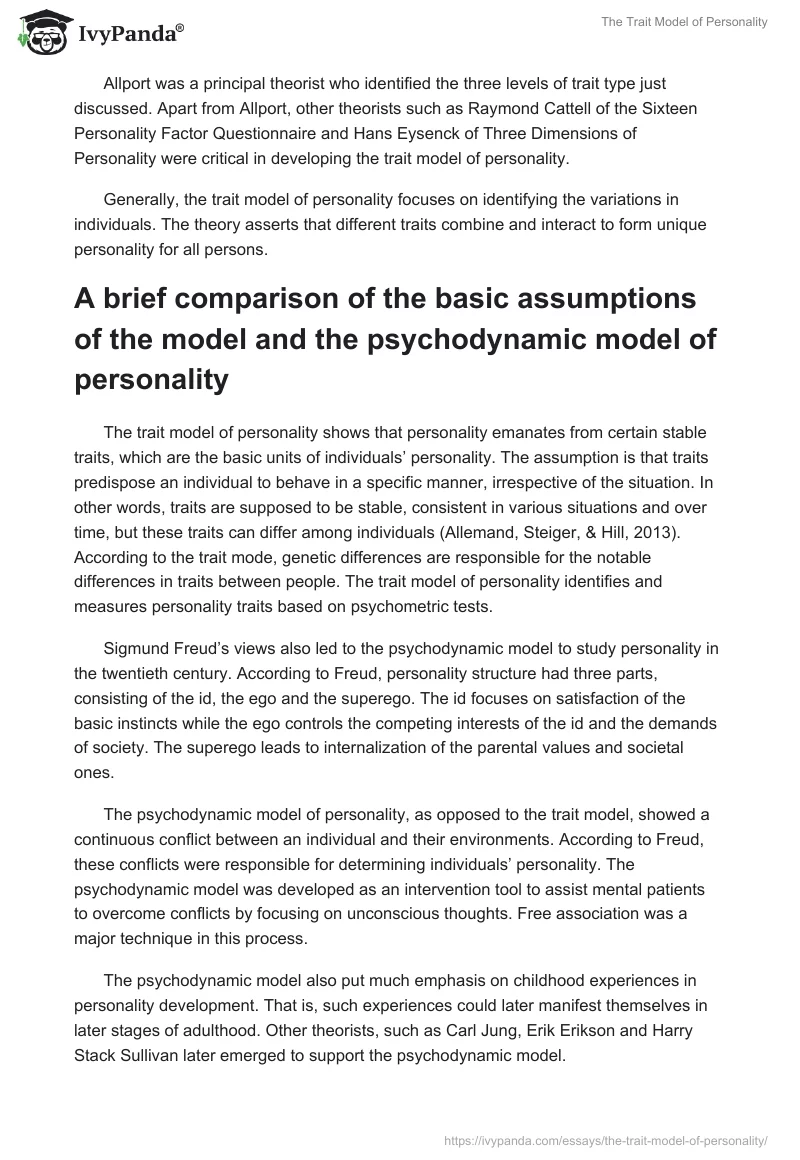An Overview of the Trait Model of Personality
The trait model of personality posits that personality is made up of several other broad traits or characters. Specifically, the model concentrates on the personality by observing differences between people. Psychologists have demonstrated that the interaction and combination of these different dispositions create personality, which is unique to every person. The trait model of personality distinguishes and assesses these different personality traits.
One major theorist of the trait model of personality is Gordon Allport. Allport observed that a certain English dictionary contained over 4,000 words to reflect a specific personality trait. Consequently, Allport was able to classify various traits into three primary trait types. First, Allport identified Cardinal Traits.
The traits are part of a person’s entire life in most cases to the extent that one may simple referred to using these traits. Individuals with cardinal traits are recognized for these personality traits, and their names are often associated or are synonymous with such traits. Allport noted that cardinal traits were rare in individuals, and they normally developed in later stages of life. Such traits could be reflected in descriptive names like Freudian, Don Juan among others.
The second types of traits identified by Allport were the central traits. According to Allport, central traits are the major characteristics that create the primary foundation of individuals’ personality. Central traits are not dominating, but they are also the most significant traits that could be used to describe people. Words such as anxious, hardworking, trustworthy and intelligent, for instance, reflect central traits in individuals.
Finally, Allport also identified secondary traits in individuals. Secondary traits often reflect individuals’ attitudes or preferences. They can only be observed in specific situations or in a given situation. For example, some people may become worried when addressing a gathering or become annoyed when no services are provided.
Allport was a principal theorist who identified the three levels of trait type just discussed. Apart from Allport, other theorists such as Raymond Cattell of the Sixteen Personality Factor Questionnaire and Hans Eysenck of Three Dimensions of Personality were critical in developing the trait model of personality.
Generally, the trait model of personality focuses on identifying the variations in individuals. The theory asserts that different traits combine and interact to form unique personality for all persons.
A brief comparison of the basic assumptions of the model and the psychodynamic model of personality
The trait model of personality shows that personality emanates from certain stable traits, which are the basic units of individuals’ personality. The assumption is that traits predispose an individual to behave in a specific manner, irrespective of the situation. In other words, traits are supposed to be stable, consistent in various situations and over time, but these traits can differ among individuals (Allemand, Steiger, & Hill, 2013). According to the trait mode, genetic differences are responsible for the notable differences in traits between people. The trait model of personality identifies and measures personality traits based on psychometric tests.
Sigmund Freud’s views also led to the psychodynamic model to study personality in the twentieth century. According to Freud, personality structure had three parts, consisting of the id, the ego and the superego. The id focuses on satisfaction of the basic instincts while the ego controls the competing interests of the id and the demands of society. The superego leads to internalization of the parental values and societal ones.
The psychodynamic model of personality, as opposed to the trait model, showed a continuous conflict between an individual and their environments. According to Freud, these conflicts were responsible for determining individuals’ personality. The psychodynamic model was developed as an intervention tool to assist mental patients to overcome conflicts by focusing on unconscious thoughts. Free association was a major technique in this process.
The psychodynamic model also put much emphasis on childhood experiences in personality development. That is, such experiences could later manifest themselves in later stages of adulthood. Other theorists, such as Carl Jung, Erik Erikson and Harry Stack Sullivan later emerged to support the psychodynamic model.
The five traits included in the big five model
Based on the research of personality traits conducted by Cattell and Eysenck, the Big Five Model was developed to account for individual traits. The model has introduced five primary traits, which interact to create a single personality in individuals (Schacter, Gilbert, & Wegner, 2011).
Extraversion is the tendency to behave actively, sociably, positive emotions, people-oriented, show optimism and empathy. These individuals also tend to be talkative. Individuals who demonstrate high-levels of extraversion are normally perceived as domineering and attention-seekers. On the contrary, individuals with low levels of extraversion tendencies are considered as reserved and may be mistaken as aloof in a given situation. Researchers have shown that such tendencies can change in advanced ages (Mõttus, Johnson, Starr, & Dearya, 2012).
The model presents Openness to Experience as a core element. Individuals tend to be imaginative, curious, inventive and could demonstrate unorthodox beliefs and values. They are adventurous, appreciate art and experiment with new ideas. This core element is associated with intellectual curiosity, originality and preference for creativity and progress.
Openness also reflects independence, imagination while it shows that people can prefer activities that go beyond the expected norms of society or strict routines (Cobb-Clark & Schurer, 2012). People may be perceived as unfocused or unpredictable when they display high degree of openness. On the other hand, low openness is reflected through data-driven and pragmatic tendencies as well as dogmatic behaviors.
Another core element of the model is agreeableness. Agreeable persons are helpful, good-natured, selfless and trusting. They are compassionate and collaborative toward other people. These individuals are not antagonistic or suspicious and well tempered to other people. To some extent, agreeable persons may be perceived as submissive when they display high-levels of the trait. Conversely, low agreeable traits depict competition, which other individuals may view as untrustworthy or argumentative.
Conscientiousness personalities are associated with individuals who are reliable, hardworking and ambitious, as well as self-driven, self-disciplined and time oriented. They are efficient and highly organized. Such traits show the desire for self-growth, achievement and well-planned strategies. Stubbornness has been associated with individuals who display high conscientiousness while flexibility is noted in low levels, but such individuals may be considered as unreliable.
Finally, neuroticism shows emotional instability that could lead to psychological problems. Neuroticism is associated with high ease of being angry, experiencing anxiety and depression. It generally reflects the level of emotional stability in individuals. High-levels of stability show that individuals are calm and possess stable personality.
However, such people may also be seen as unconcerned or lack inspiration in certain situations. Conversely, low levels are associated with reactive and dynamic personality traits. People consider individuals with such traits as insecure or unstable (Jeronimus, Ormel, Aleman, Penninx, & Riese, 2012).
My Scores on the Big Five Personality Test
I participated in online personality test for the Big Five Model. Here are my results. Openness to Experience/Intellect score was 84 percent, which showed that I tend to original, curious, complex, and creative. Overall, I enjoy have novel experiences and experiencing things in a new way.
My score for Conscientiousness was 94 percent. It is noted that high scorers tend to be reliable, well-organized, self-disciplined, careful. Thus, the test proved that I am well-organized and can be relied upon by others.
For Extraversion, I scored 59 percent. The measurement tool showed that high scorers tend to be sociable, friendly, fun loving, talkative while low scorers tend to be introverted, reserved, inhibited, quiet. In this case, my score shows that I am neither particularly social nor reserved.
My score for Agreeableness was 90 percent. The assessment tool showed that high scores are associated with good natured, sympathetic, forgiving, courteous people. Thus, I am good-natured, courteous, and supportive individual.
Finally, my scores on Neuroticism was 5 percent. The test tool depicted that high scorers tend to be nervous, high-strung, insecure, worrying while low scorers tend to be calm, relaxed, secure, and hardy. It was concluded that I would perhaps stay calm, even in tense situations.
Overall, personality models assist individuals to understand how traits and behaviors are developed and expressed in different situations. More studies have focused in applications findings in various situations (Mehta & Madnawat, 2012).
References
Allemand, M., Steiger, A. E., & Hill, P. L. (2013). Stability of personality traits in adulthood: Mechanisms and implications. GeroPsych: The Journal of Gerontopsychology and Geriatric Psychiatry, 26(1), 5-13.
Cobb-Clark, D. A., & Schurer, S. (2012). The stability of big-five personality traits. Economics Letters, 115(1), 11–5. Web.
Jeronimus, B. F., Ormel, J., Aleman, A., Penninx, B., & Riese, H. (2012). Negative and positive life events are associated with small but lasting change in neuroticism. Psychological Medicine, 43(11), 2403–15. Web.
Mehta, P., & Madnawat, A. V. (2012). Personality as a predictor of burnout among managers of manufacturing industries. Journal of the Indian Academy of Applied Psychology, 38(2), 321-328.
Mõttus, R., Johnson, W., Starr, J. M., & Dearya, I. J. (2012). Correlates of personality trait levels and their changes in very old age: The Lothian Birth Cohort 1921. Journal of Research in Personality, 46(3), 271–8. Web.
Schacter, D., Gilbert, D., & Wegner, D. (2011). Psychology (2nd ed.). New York: Worth.


